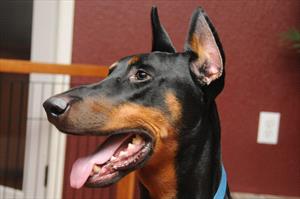Anne E. Katherman, DVM, DACVIM (Neurology)
Sept29DobieDVDShots 421 (1).jpg

“Wobbler syndrome” is the common term used for the spinal disease cervical vertebral instability, (CVI). The name comes from the weak, uncoordinated gait dogs with the condition have, giving the appearance of “wobbling” as they move.
What is it?
Wobbler syndrome affects the neck and spine in dogs. Dogs with CVI experience compression of the spinal cord and the spinal nerve roots, causing either neck or back pain or both, and gait problems. A narrowing, or stenosis, of the spinal canal and spinal nerve passages in the neck may occur.
Causes
CVI is divided into two types. One type is associated with the gel-filled disks in the spine that act as a cushion between the vertebrae. If these disks degrade and rupture, it causes spinal compression and affects nerves and blood vessels. Doberman pinschers are most commonly affected with this type of CVI.
In the second type, dogs may have a type of osteoarthritis caused by a misshaped vertebra, causing the spinal cord to be compressed. This type of CVI is suspected to be inherited and occurs more commonly in Great Danes and other large breed dogs. CVI has not been seen in cats.
Symptoms and Diagnosis
While the first signs of wobblers are often an abnormal gait, symptoms include neck pain and stiffness, lameness or stiffness in the dog’s front legs or shoulders, and difficulty standing or laying down. Your dog can have weakness in the front or hind legs and not want to move, leading eventually to muscle weakness and deterioration. The disease can become so severe as to cause partial or complete paralysis in all four legs.
Your dog may have a chronic condition, seeming to have weakness or pain that gets worse over time, or the signs of CVI may come on suddenly. Your veterinarian will likely recommend radiographs or MRI (magnetic resonance imaging). MRI is the preferred method for evaluating CVI because it identifies the site, severity, and nature of the compression.
Treatment
If symptoms of CVI are mild in your dog, reducing exercise is recommended. Using a harness instead of a collar puts less pressure on your dog’s neck. If overweight, reducing calories may be suggested. Your veterinarian may prescribe anti-inflammatory medications.
In more severe cases, your veterinarian may recommend surgery to help stabilize your dog’s spine. Approximately 40-54% of dogs with CVI that don’t require surgery improve. With surgery, about 80% of dogs improve. With or without surgery, your veterinarian will monitor your dog’s progress and response to treatment.